Football is a popular sport that is loved and watched by millions of fans around the world. It is a game that requires physicality, strength, and skill.
However, with the physical nature of the game comes the potential risk of injuries, especially head injuries. In recent years, the importance of head safety in football has gained increased attention due to the long-term effects of such injuries.
This article will explore the significance of head safety in football and the steps being taken to protect players from head injuries.
The Dangers of Head Injuries
Head injuries in football can range from mild concussions to more severe traumatic brain injuries. These injuries can have both short-term and long-term effects on players.
In the short term, head injuries can cause symptoms such as dizziness, nausea, headache, and confusion. In more severe cases, players may lose consciousness or experience memory loss.
Long-term effects of repeated head injuries can include chronic traumatic encephalopathy (CTE), a degenerative brain disease that can lead to memory loss, depression, and even premature death.
The Impact on Players’ Lives
Head injuries in football can have a significant impact on players’ lives. Not only do they affect players’ physical health, but they can also impact their mental well-being and overall quality of life.
Many former football players have spoken out about the lasting effects of head injuries and have highlighted the need for increased head safety measures in the sport.
One such example is former NFL player Chris Borland, who decided to retire from professional football at the age of 24 due to concerns about head injuries and the potential long-term effects on his health.
His decision sparked a conversation about the importance of head safety in football and prompted the NFL to take a closer look at its policies and protocols regarding head injuries.
Steps Taken to Protect Players
In recent years, various measures have been implemented to enhance head safety in football. These measures include changes to the rules of the game, improvements in equipment, and increased awareness and education about head injuries.
Rule Changes
The governing bodies of football, such as FIFA and NFL, have implemented rule changes to reduce the risk of head injuries during games.
For example, rules regarding tackling technique and targeting the head have been tightened to discourage dangerous plays. These rule changes aim to protect the players from unnecessary risks and promote safer gameplay.
Improved Equipment
Advancements in technology have led to the development of improved equipment designed to protect players’ heads. Football helmets, in particular, have undergone significant improvements to better absorb and dissipate the impact of collisions.
These helmets now feature padding and materials that help to reduce the risk of head injuries. Additionally, mouthguards have also become an essential part of player safety equipment, as they can help prevent concussions by absorbing and redirecting the force of a blow to the head.
Awareness and Education
Increasing awareness and education about head injuries is crucial in promoting head safety in football. Coaches, players, and parents need to be informed about the risks associated with head injuries and the proper protocols for dealing with them.
Training programs and seminars focused on head safety have been implemented to educate those involved in the sport.
Furthermore, many leagues and organizations have developed concussion protocols to ensure that players receive appropriate medical attention in the event of a head injury.
These protocols involve assessing players for signs and symptoms of a concussion and requiring medical clearance before they can return to play.
The Role of Research
Research plays a vital role in understanding the long-term effects of head injuries and developing strategies to prevent and treat them.
Scientists and medical professionals are constantly studying the impact of head injuries on football players and exploring ways to minimize the risk and improve player safety.
Conclusion
Head safety in football is of utmost importance due to the potential risks and long-term effects of head injuries.
The dangers of head injuries have prompted significant changes in the sport, including rule changes, improved equipment, increased awareness, and education. However, there is still more work to be done. Continued research and ongoing efforts to improve head safety will ensure that players can enjoy the game while minimizing the risk of head injuries and their devastating consequences.



























